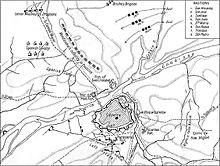First siege of Badajoz (1811) facts for kids
Quick facts for kids First siege of Badajoz (1811) |
|||||||
|---|---|---|---|---|---|---|---|
| Part of Peninsular War | |||||||
 Map of the Battle of the Gebora and the first siege of Badajoz |
|||||||
|
|||||||
| Belligerents | |||||||
| Commanders and leaders | |||||||
| Strength | |||||||
| 17,000 | 21,000 | ||||||
| Casualties and losses | |||||||
| 1,500 killed or wounded | 7,000 killed or wounded 14,000 captured |
||||||
The first siege of Badajoz was a military attack on the Spanish town of Badajoz. This event happened during the Peninsular War. French General Soult led the attack.
The siege began on January 27, 1811. General Gazan's 6,000 soldiers, who were bringing the heavy siege cannons, arrived later on February 3. The day before, Soult had sent General Latour-Maubourg's six cavalry groups. They crossed the Guadiana river to block the northern path to the fortress.
Contents
Why did the siege happen?
The Peninsular War was a long conflict in Spain and Portugal. The first siege of Badajoz was part of a time when neither side could make much progress in the western part of the war. This period is often called the stalemate in the west.
Getting ready for the attack
General Soult wanted to capture the Spanish fortress at Badajoz. He hoped this would make the Allied forces move away from another important battle area. He led about 20,000 soldiers into a region called Extremadura.
Soult split his army into two groups. They marched into Extremadura from two main mountain passes. Their plan was to meet up again at Almendralejo. One group, led by Latour-Maubourg, met some Spanish and Portuguese cavalry. This happened near Usagre on January 3, 1811. But this was just a small group covering the retreat of Spanish soldiers. So, Latour-Maubourg was able to reach Almendralejo and wait for Soult's other group.
The attack on Olivenza
Soult realized his army was not strong enough yet to attack a big fortress like Badajoz. So, he changed his plans. He sent his light cavalry (fast horse soldiers) to take Mérida. He also left some dragoons (soldiers who could fight on horseback or on foot) at Albuera. Their job was to watch the soldiers in Badajoz. Then, Soult marched with the rest of his army to surround Olivenza.
The siege of Badajoz
In September 1810, Rafael Menacho became a high-ranking officer. He was put in charge of Badajoz as its military and civil governor. He also commanded the soldiers defending the city.
At the start of 1811, about 4,100 soldiers were defending Badajoz. Before leaving for Portugal, General Mendizábal added two more groups of soldiers. This brought the total Spanish troops there to 5,000.
After Mendizábal's army was defeated at Gebora, the remaining soldiers fled to Badajoz. This added over 3,000 more troops to the city's defense. So, the total number of soldiers defending Badajoz grew to over 8,000.
On March 3, Menacho ordered a surprise attack from the city. His soldiers managed to disable twelve of the enemy's cannons. These cannons were in the closest attacking positions. However, while Menacho was watching the fight from the castle walls, he was killed by a random shot. The next week, the new commander, Brigadier José Imaz, held a meeting with his officers. They decided to surrender the city to General Mortier.
What did historians say?
A historian named Oman wrote about this war. In his book, he was very critical of Imaz's decision to surrender. He pointed out that Badajoz still had enough food for 8,000 soldiers for over a month. It also had more than 150 working cannons and plenty of gunpowder.
Oman believed that if Menacho had lived, the city would have held out longer. He thought it would have waited until help arrived. Help was on its way from Beresford's army, which was ordered to move on March 12. Beresford's forces would have reached Badajoz around March 18.
What happened next?
After this siege, the stalemate in the west continued. This led to the second siege of Badajoz.
See also

